Grand Ole Opry
 | |
| Genre | Country, bluegrass, gospel |
|---|---|
| Running time | 30-minute segments (7:00 pm–9:30 pm) |
| Country of origin | United States |
| Language(s) | English |
| Home station |
WSM radio Sirius XM satellite radio |
| Announcer | Eddie Stubbs |
| Created by | George D. Hay |
| Recording studio | Nashville, Tennessee |
| Original release | November 28, 1925 – present |
| Sponsored by | |
| Website |
www |
The Grand Ole Opry is a weekly country music stage concert in Nashville, Tennessee founded on November 28, 1925, by George D. Hay as a one-hour radio "barn dance" on WSM. Currently owned and operated by Opry Entertainment (a division of Ryman Hospitality Properties, Inc.), it is the longest running radio broadcast in US history.[1][2] Dedicated to honoring country music and its history, the Opry showcases a mix of famous singers and contemporary chart-toppers performing country, bluegrass, Americana, folk, and gospel music as well as comedic performances and skits.[3] It attracts hundreds of thousands of visitors from around the world and millions of radio and internet listeners.
The Opry's current primary slogan is "The Show That Made Country Music Famous."[4] Other slogans include "Home of American Music" and "Country’s Most Famous Stage."[3]
In the 1930s, the show began hiring professionals and expanded to four hours. Broadcasting by then at 50,000 watts, WSM made the program a Saturday night musical tradition in nearly 30 states.[5] In 1939, it debuted nationally on NBC Radio. The Opry moved to a permanent home, the Ryman Auditorium, in 1943. As it developed in importance, so did the city of Nashville, which became America's "country music capital."[6] The Grand Ole Opry holds such significance in Nashville that its name is included on the city/county line signs on all major roadways. The signs read "Music City|Metropolitan Nashville Davidson County|Home of the Grand Ole Opry."
Membership in the Opry remains one of country music's crowning achievements.[7] Such country music legends as Hank Williams, Johnny Cash, Patsy Cline, Marty Robbins, Roy Acuff, the Carter family, Bill Monroe, Ernest Tubb, Kitty Wells, and Minnie Pearl were regulars on the Opry's stage throughout its history. In recent decades, the Opry has hosted such contemporary country stars as Dolly Parton, Loretta Lynn, Alan Jackson, Garth Brooks, Reba McEntire, Josh Turner, Carrie Underwood, Brad Paisley, Rascal Flatts, Dierks Bentley, Little Big Town, Blake Shelton, Chris Young, and Ricky Skaggs. Since 1974, the show has been broadcast from the Grand Ole Opry House east of downtown Nashville, with an annual three-month winter foray back to the Ryman since 1999. In addition to the radio programs, performances have been sporadically televised over the years.
History
Beginnings

The Grand Ole Opry started as the WSM Barn Dance in the new fifth-floor radio studio of the National Life & Accident Insurance Company in downtown Nashville on November 28, 1925. On October 18, 1925, management began a program featuring "Dr. Humphrey Bate and his string quartet of old-time musicians." On November 2, WSM hired long-time announcer and program director George D. "Judge" Hay, an enterprising pioneer from the National Barn Dance program at WLS in Chicago, who was also named the most popular radio announcer in America as a result of his radio work with both WLS and WMC in Memphis, Tennessee. Hay launched the WSM Barn Dance with 77-year-old fiddler Uncle Jimmy Thompson on November 28, 1925, and that date is celebrated as the birth date of the Grand Ole Opry.[8]
Some of the bands regularly on the show during its early days included Bill Monroe, the Possum Hunters (with Dr. Humphrey Bate), the Fruit Jar Drinkers with Uncle Dave Macon, the Crook Brothers, the Binkley Brothers' Dixie Clodhoppers, Sid Harkreader, Deford Bailey, Fiddlin' Arthur Smith, and the Gully Jumpers.[9]
Judge Hay liked the Fruit Jar Drinkers and asked them to appear last on each show because he wanted to always close each segment with "red hot fiddle playing." They were the second band accepted on Barn Dance, with the Crook Brothers being the first. When the Opry began having square dancers on the show, the Fruit Jar Drinkers always played for them. In 1926, Uncle Dave Macon, a Tennessee banjo player who had recorded several songs and toured on the vaudeville circuit became its first real star.[9]
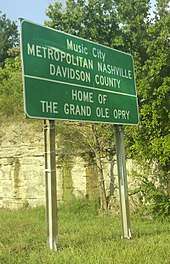
Name
The phrase "Grand Ole Opry" was first uttered on the air on December 10, 1927.[10] At the time, Barn Dance followed the NBC Red Network's Music Appreciation Hour, a program with classical music and selections from grand opera presented by classical conductor Walter Damrosch. On that particular night, Damrosch remarked that "there is no place in the classics for realism." In response, Opry presenter George Hay said:
Friends, the program which just came to a close was devoted to the classics. Doctor Damrosch told us that there is no place in the classics for realism. However, from here on out for the next three hours, we will present nothing but realism. It will be down to earth for the "earthy."
Hay then introduced DeFord Bailey, the man he had dubbed the "Harmonica Wizard", saying:
For the past hour, we have been listening to music taken largely from Grand Opera. From now on, we will present the "Grand Ole Opry."
Bailey then stepped up to the mic to play "The Pan-American Blues," his song inspired by the Pan-American, a premier L&N Railroad passenger train.[10][11]
Larger venues
As audiences for the live show increased, National Life & Accident Insurance's radio venue became too small to accommodate the hordes of fans. They built a larger studio, but it was still not large enough. After several months with no audiences, National Life decided to allow the show to move outside its home offices. In October 1934, the Opry moved into then-suburban Hillsboro Theatre (now the Belcourt) before moving to the Dixie Tabernacle in East Nashville on June 13, 1936. The Opry then moved to the War Memorial Auditorium, a downtown venue adjacent to the State Capitol, and a 25-cent admission fee was charged to try to curb the large crowds, but to no avail. On June 5, 1943, the Opry moved to Ryman Auditorium.
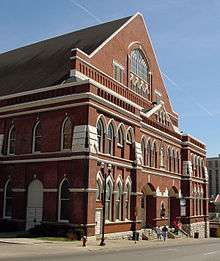
Top-charting country music acts performed at the Opry during the Ryman years, including Roy Acuff – called the King of Country Music – Hank Williams, Webb Pierce, Faron Young, Martha Carson, Lefty Frizzell, and many others.
One hour of the Opry was nationally broadcast by the NBC Red Network from 1939 to 1956, and for much of its run, it aired one hour after the program that had inspired it, National Barn Dance. The NBC segment, originally known by the name of its sponsor, The Prince Albert Show, was first hosted by Acuff, who was succeeded by Red Foley from 1946 to 1954. From October 15, 1955 to September 1956, ABC-TV aired a live, hour-long television version once a month on Saturday nights (sponsored by Ralston-Purina) that pre-empted one hour of the then-90-minute Ozark Jubilee. From 1955 to 1957, Al Gannaway owned and produced both The Country Show and Stars of the Grand Ole Opry, both filmed programs syndicated by Flamingo Films. Gannaway's Stars of the Grand Ole Opry was the first television show shot in color.[12]
On October 2, 1954, a teenage Elvis Presley had his only Opry performance. Although the audience reacted politely to his revolutionary brand of rockabilly music, Opry manager Jim Denny told Presley's producer Sam Phillips after the show that the singer's style did not suit the program.[13]
1960s
In the 1960s, as the hippie counterculture movement spread, the Opry maintained a strait-laced, conservative image with "longhairs" not being featured on the show. The Byrds were a notable exception. Country rock pioneer Gram Parsons, who was a member of The Byrds at the time, was in Nashville to work on the band's country rock album, Sweetheart of the Rodeo.[14] The band's record label, Columbia Records, had arranged for The Byrds to perform at the Ryman on March 15, 1968, a prospect that thrilled Parsons.[14] However, when the band took the stage the audience's response was immediately hostile, resulting in derisive heckling, booing, and mocking calls of "tweet, tweet" and "cut your hair"[15][16] The Byrds further outraged the Opry establishment by ignoring accepted protocol when they performed Parsons' song "Hickory Wind" instead of the Merle Haggard song "Life in Prison," as had been announced by Tompall Glaser.[14] Two decades later, long after Parsons's death, members of The Byrds reconciled with the Opry and collaborated on the 1989 album Will the Circle Be Unbroken: Volume Two.
Another artist that ran afoul of the Opry's stringent standards was Jerry Lee Lewis, who made his first and only appearance on the show on January 20, 1973, after several years of success on the country charts. Lewis was given two conditions for his appearance – no rock and roll and no profanity – and he proceeded to disregard both, even referring to himself as a certain unairable maternal insult at one point. In a continuous 40-minute set, Lewis played a mixture of his rock and roll hits and covers of other singers' country songs. It has been said that he was bitter about how he was treated when he first arrived in Nashville in 1955, and he supposedly used his Opry appearance to exact revenge on the Nashville music industry.[17]
Grand Ole Opry House
|
Grand Ole Opry House | |
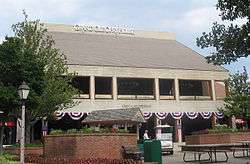 Grand Ole Opry House | |
  | |
| Location | 2804 Opryland Drive, Nashville, Tennessee 37214[18] |
|---|---|
| Coordinates | 36°12′24″N 86°41′32″W / 36.20667°N 86.69222°WCoordinates: 36°12′24″N 86°41′32″W / 36.20667°N 86.69222°W |
| Area | 4 acres (approx.)[18] |
| Built | 1972-74[18] |
| Architect | Welton Becket & Associates; Pierre Cabrol[18] |
| Architectural style | Modern/Brutalist[18] |
| Restored | 2010 (flood damage remediation) |
| NRHP reference # | 14001222[19] |
| Added to NRHP | January 27, 2015 |
Ryman Auditorium was home to the Opry until 1974. By the late 1960s, National Life & Accident desired a new, larger, more modern home for the long-running radio show. Already 51 years old at the time the Opry moved there, the Ryman was beginning to suffer from disrepair as the downtown neighborhood around it fell victim to increasing urban decay. Despite these shortcomings, the show's popularity continued to increase, and its weekly crowds were outgrowing the 3,000-seat venue. The Opry's operators wanted to build a new air-conditioned theater, with greater seating capacity, ample parking, and the ability to serve as a television production facility. The ideal location would be in a less urbanized part of town to provide visitors with a safer, more controlled, and more enjoyable experience.[20]
National Life & Accident purchased farmland owned by a local sausage manufacturer (Rudy's Farm) in the Pennington Bend area of Nashville, nine miles east of downtown and adjacent to the newly constructed Briley Parkway. The new Opry venue was the centerpiece of a grand entertainment complex at that location, which later included Opryland USA Theme Park and Opryland Hotel. The theme park opened to the public on June 30, 1972,[21] well ahead of the 4,000-seat Opry House, which debuted nearly two years later, on Saturday, March 16, 1974.
Opening night was attended by sitting U.S. President Richard Nixon, who played a few songs on the piano.[22] To carry on the tradition of the show's run at the Ryman, a six-foot circle of oak was cut from the corner of the Ryman's stage and inlaid into center stage at the new venue.[23] Artists on stage usually stood on the circle as they performed, and most modern performers still follow this tradition.
The theme park was closed and demolished following the 1997 season, but the Grand Ole Opry House remains in use. The immediate area around it was left intact, even throughout the construction of Opry Mills, which opened in May 2000.
The Grand Ole Opry continues to be performed every Tuesday, Friday, and Saturday at the Grand Ole Opry House from March through November each year, and the site was added to the National Register of Historic Places on January 27, 2015.[24][25].

Return to Ryman Auditorium
Following the departure of the Opry, Ryman Auditorium sat mostly vacant and decaying for 20 years. An initial effort by National Life & Accident to tear down the Ryman and use its bricks to build a chapel at Opryland USA was met with resounding resistance from the public, including many influential musicians of the time. The plans were abandoned, and the building remained standing with an uncertain future. Despite the absence of performances, the building remained a tourist attraction with tours.[26]
In 1991 and 1992, Emmylou Harris performed a series of concerts there and released some of the recordings as an album entitled At the Ryman. The concert and album's high acclaim renewed interest in reviving Ryman Auditorium as an active venue. Beginning in September 1993, Gaylord Entertainment initiated a full renovation of the Ryman, restoring it to a world-class concert hall that reopened with a broadcast of A Prairie Home Companion on June 4, 1994.[26]
On Sunday, October 18, 1998, the Opry held a benefit show at Ryman Auditorium, marking its return to the venue for the first time since its final show on March 15, 1974.[27] The show was well received by fans, performers, and management alike, and the decision was made to host the Opry's regular shows there on January 15 & 16, 1999, as part of the celebration to commemorate 25 years at the new venue.
Beginning in November 1999, the Opry was held at Ryman Auditorium for three months, partly due to the ongoing construction of Opry Mills. The Opry has returned to the Ryman for the three winter months every year since then, allowing the show to acknowledge its roots while also taking advantage of a smaller venue during an off-peak season for tourism.[27] While still officially the Grand Ole Opry, the shows there are billed as Opry at the Ryman. From 2002 to 2014, a traveling version of the Radio City Christmas Spectacular took up residence at the Grand Ole Opry House each holiday season while the Opry was away. It was replaced by Dr. Seuss' How the Grinch Stole Christmas! The Musical beginning in 2015.[28]
2010 flooding
In May 2010, the Opry House was flooded, along with much of Nashville, when the Cumberland River overflowed its banks. Repairs were made, and the Opry itself remained uninterrupted. Over the course of the summer of 2010, the broadcast temporarily originated from alternate venues in Nashville, with Ryman Auditorium hosting the majority of the shows. Other venues included TPAC War Memorial Auditorium, another former Opry home; TPAC's Andrew Jackson Hall; Nashville Municipal Auditorium; Allen Arena at Lipscomb University; and Two Rivers Baptist Church.[29]
Much of the auditorium's main floor seating, the backstage areas, and the entire stage – including the inlaid circle of wood from Ryman's stage – was underwater during the flood. While the Grand Ole Opry House's stage was replaced, the Ryman circle was restored and again placed at center stage in the Grand Ole Opry House before shows resumed.[30][31] The renovations following the flood also resulted in an updated backstage area, including the construction of more dressing rooms and a performer's lounge.
The Opry returned to the Grand Ole Opry House on September 28, 2010, in a special edition of the Opry entitled Country Comes Home that was televised live on Great American Country. The evening was filled with one-of-a-kind Opry moments. Martina McBride and Connie Smith sang Smith's signature hit "Once a Day" together, and other collaborations included Dierks Bentley and Del McCoury ("Roll On Buddy, Roll On"), Josh Turner and Lorrie Morgan ("Golden Ring"), and Montgomery Gentry and Charlie Daniels Band ("Devil Went Down To Georgia"), among others. The show closed with an all-star guitar jam featuring Brad Paisley, Keith Urban, Steve Wariner, Ricky Skaggs, and Marty Stuart.[32]
Broadcasts
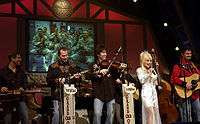
The Grand Ole Opry is broadcast live on WSM-AM at 7 p.m. CT on Saturday nights, changed from a previous time start of 6:30. A similar program, Friday Night Opry, airs live on Friday nights.From February through December, Tuesday Night Opry is also aired live.[33] Wednesday shows are typically presented in the summer months, while an "Opry Country Classics" program sporadically airs on Thursdays, devoted solely to older artists and broadcasting from Ryman Auditorium. The length of each of the various shows varies; typically, the show runs three nights a week for just over two hours each night, with Saturday night shows often extended as late as midnight.
The Opry can also be heard live on Willie's Roadhouse on channel 59 on Sirius XM Satellite Radio, and the program streams on WSM's website.[33] ABC broadcast the Grand Ole Opry as a monthly series from 1955 to 1956, and PBS televised annual live performances from 1978 to 1981.[34] In 1985, The Nashville Network began airing an edited half-hour version of the program as Grand Ole Opry Live. The show moved to Country Music Television, where it expanded to an hour, and then to the Great American Country (GAC) cable network,[35] which no longer televised its Opry Live show.[36] RFD-TV carries reruns of Opry telecasts under the title Opry Encore.[37]
Membership

Regular performers at the Grand Ole Opry can be inducted into the organization as a member; the Opry management, when it decides to induct a new member, directs an existing member to publicly ask them to join, usually during a live episode. As the Opry is a running series, membership in the show's cast must be maintained throughout an artist's career, through frequent performances, and expires when the performer dies (in the case of duos, membership continues until both members die, with the survivor allowed to maintain membership after the other's death). The Opry maintains a wall of fame listing every member of the Opry in the show's history, including those that have died, lost or relinquished their membership. Receiving Opry membership is considered an honor that is similar in prestige to a hall of fame induction, with the caveat that a number of prominent country musicians (Conway Twitty, George Strait, Buck Owens and Merle Haggard being some of the most successful examples) never received it.
The Opry also maintains a list of active "guest musicians" without official Opry membership (over 400 as of July 2018) who appear on the show.
Controversies
In April 1963, Opry management made a rule that members had to perform on at least 26 shows a year to keep their memberships active.[38] WSM dropped the number of required performances to 20 in January 1964,[38] and the minimum number was 12 in 2000.[39] Although the minimum number of performances has been reduced over the years, artists offered membership are expected to show their dedication to the Opry with frequent attendance.[39]
Another controversy raged for years over allowable instrumentation, especially the use of drums and electrically amplified instruments. Some purists were appalled at the prospect; traditionally a string bass provided the rhythm component in country music, and percussion instruments were seldom used. Electric amplification, new in the beginning days of the Opry, was regarded as the province of popular music and jazz in the 1940s. Although the Opry allowed electric guitars and steel guitars by World War II, the restrictions against drums and horns continued, causing a conflict when Bob Wills[40] and Pee Wee King[41] defied the show's ban on drums.
Stonewall Jackson, the Opry's longest-tenured standing member as of 2018, sued the Opry management in 2008 alleging that manager Pete Fisher was trying to purge older members of the Opry from its membership and committing age discrimination.[42] Jackson settled the lawsuit later that year.[43]
Commercialization
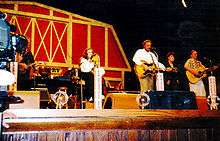
The company has enforced its trademark on the name "Grand Ole Opry," with trademark registrations in the United States and in numerous countries around the world. It has taken court action to limit use of the word "Opry" – not directly trademarked – to members of the Opry and products associated with or licensed by it and to discourage use of the word in ways that would imply a connection to the Grand Ole Opry.[44] In late 1968, for instance, WSM sued Opry Records, a record label that was independent of WSM,[45] and the court decided that "the record is replete with newspaper and magazine articles and clippings which demonstrate conclusively that the term 'Opry,' standing alone as defendant has used it, is constantly used in country and western music circles in referring to plaintiff's 'Grand Ole Opry'."[46] The court also stated "the defendant has appropriated, at its peril, the dominant or salient term in the plaintiff's mark, a term which identified the 'Grand Ole Opry' in the mind of the public many years before the inception of 'Opry Records' – the name adopted by defendant."[47]
In another case, the Trademark Trial and Appeal Board granted summary judgment that the term "Opry" is a generic term (and thus no more protected than the words "Grand" or "Ole"), but the Federal Circuit court reversed this decision.[48] As recently as 2009, the Trademark Trial and Appeal Board granted judgment against Texas Opry House, LLC, which had filed a trademark application for TEXAS OPRY HOUSE.[49]
In 2004, it was announced that the Grand Ole Opry had contracted for the first time with a "presenting sponsor," Cracker Barrel, and the sponsoring company's name would be associated with Grand Ole Opry in all its advertising.[50] Humana, Inc., Cracker Barrel, and Dollar General are the present sponsors of the Opry.[51]
Honors
- Peabody Award, 1983
- National Radio Hall of Fame induction, 1992
See also
- Country Music Association
- Country Music Hall of Fame and Museum
- Music & the Spoken Word - "The longest-running continuous network radio program in the world" (began July 15th, 1929).[1]
Notes
- 1 2 "Music & the Spoken Word". National Radio Hall of Fame. Retrieved December 21, 2017.
- ↑ "Grand Ole Opry". National Radio Hall of Fame. National Radio Hall of Fame. Retrieved December 21, 2017.
radio's longest-running musical program
- 1 2 "About The Opry". Grand Ole Opry. Gaylord Entertainment. Retrieved January 26, 2010.
- ↑ "Grand Ole Opry". Gaylord Opryland. Gaylord Hotels. Retrieved January 26, 2010.
- ↑ "Music/Grand Ole Opry". The Radio Hall of Fame. Archived from the original on September 8, 2008. Retrieved January 26, 2010.
- ↑ "Grand Ole Opry". The Columbia Electronic Encyclopedia, 6th ed. Columbia University Press. Missing or empty
|url=(help);|access-date=requires|url=(help) - ↑ "Country Music History". Country Music Hall of Fame and Museum. Country Music Foundation, Inc. Archived from the original on November 3, 2010. Retrieved January 28, 2010.
- ↑ "History of the Opry". Grand Ole Opry. Retrieved August 8, 2012.
- 1 2 Tassin, Myron (1975), Fifty Years at the Grand Ole Opry (1st ed.), Pelican Publishing, ISBN 978-0882890890
- 1 2 "Deford Bailey". Country Music Hall of Fame. Archived from the original on August 19, 2011. Retrieved July 21, 2011.
- ↑ "Lost and Found Sound: The Pan American Blues". NPR. November 20, 2000. Retrieved July 21, 2011.
- ↑ "ABC-TV to Air 'Ole Opry' Live Once Monthly" (October 8, 1955), The Billboard, p. 1
- ↑ Gaar, Gillian G. "Box Set Spotlights Elvis Presley's Surviving Early Work at Sun Studio." Goldmine Feb. 2013: 40-44. Print.
- 1 2 3 Rogan, Johnny. (1998). The Byrds: Timeless Flight Revisited. Rogan House. ISBN 0-9529540-1-X.
- ↑ Allen, Michael. (2005). "I Just Want to Be a Cosmic Cowboy".
- ↑ Fricke, David. (2003). Sweetheart of the Rodeo: Legacy Edition (2003 CD liner notes).
- ↑ Dunkerley, Beville. Flashback: Jerry Lee Lewis Drops an F-Bomb on the Grand Ole Opry. Rolling Stone. Retrieved August 21, 2015.
- 1 2 3 4 5 "National Register of Historic Places Registration Form: Grand Ole Opry House" (PDF). Archived from the original (PDF) on April 2, 2015. Retrieved March 16, 2015.
- ↑ National Park Service (2010-07-09). "National Register Information System". National Register of Historic Places. National Park Service.
- ↑ The Grand Ole Opry: The Making of an American Icon - Colin Escott - Google Boeken. Books.google.com. Retrieved August 9, 2012.
- ↑ "Theme Park Timelines". Timelines.home.insightbb.com. Archived from the original on September 4, 2012. Retrieved August 9, 2012.
- ↑ Hurst, Jack Nashville's Grand Ole Opry (New York: H.N. Abrams, 1975)
- ↑ Smith, Loran (January 24, 2013). "A visit to the Grand Ole Opry brings precious memories". The News-Reporter. Retrieved November 29, 2014.
- ↑ Eleanor Kennedy, "Nashville's newest historic place: The Grand Ole Opry House", Nashville Business Journal, February 26, 2015.
- ↑ Todd Barnes, [Grand Ole Opry House added to National Register], The Tennessean, February 27, 2015.
- 1 2 The Encyclopedia of Country Music. Oxford University Press, USA. January 4, 2012. p. 444. ISBN 978-0-19-992083-9.
- 1 2 Fay, Byron (January 25, 2010). "Grand Ole Opry Ryman Reunion Celebration-October 18, 1998". Fayfare's Opry Blog. Retrieved June 29, 2015.
- ↑ "The Grinch to Steal Christmas in Nashville". PR Newswire. May 13, 2015. Retrieved June 29, 2015.
- ↑ "Home | Grand Ole Opry". Search2.opry.com. Retrieved February 5, 2014.
- ↑ Cooper, Peter (May 10, 2010). "Opry House's famed circle stays center stage after flood". USA Today. Retrieved June 29, 2015.
- ↑ Hackett, Vernell (August 25, 2010). "Grand Ole Opry Floor Restored for September 28 Reopening". TheBoot.com. Retrieved June 29, 2015.
- ↑ Archived August 31, 2013, at the Wayback Machine.
- 1 2 "Tune In". Grand Ole Opry. Retrieved December 9, 2012.
- ↑ Fay, Byron. "First Televised Opry Show on PBS-March 4, 1978". FayFare's Opry Blog. Retrieved December 9, 2012.
- ↑ "History of the Opry". Grand Ole Opry. Retrieved December 9, 2012.
- ↑ "GAC's Presents Opry Live". GAC (Great American Country). Archived from the original on September 6, 2012. Retrieved December 9, 2012.
- ↑ "Opry Encore".
- 1 2 "Four Dropped From 'Opry' To Return on Christmas". Billboard: 50. November 27, 1965.
- 1 2 Morris, Edward (April 20, 2000). "Grand Ole Opry Looking Toward Building Its Audience". CMT/CMT News. Retrieved December 9, 2012.
- ↑ Kienzle, Richard. (2003). Southwest shuffle: pioneers of honky-tonk, Western swing, and country jazz. New York: Routledge. pp. 254-257.
- ↑ Hall, Wade. (1998). "Pee Wee King". In The Encyclopedia of Country Music. Paul Kingsbury, Editor. New York: Oxford University Press. pp. 283–4.
- ↑ Yahoo! News, 1/12/07
- ↑ "Stonewall Jackson's Lawsuit Against Opry Settled" Cmt.com, October 6, 2008
- ↑ "WSM Back in Court Again - Files 2d Suit Over Name". Billboard. 81 (21): 51. May 24, 1969.
- ↑ "Opry Records Sued For Infringement". Billboard. 80 (50): 29. December 14, 1968. Retrieved December 9, 2012.
- ↑ WSM v. Bailey, United States District Court for the Middle District of Tennessee.297 F. Supp. 870 (M.D. Tenn. 1969), at 872-3.
- ↑ WSM v. Bailey, 297 F. Supp. 870 (M.D. Tenn. 1969), at 873.
- ↑ Opryland USA, Inc. v. The Great American Music Show, Inc., 970 F.2d 847 (Fed. Cir. 1992).
- ↑ US Trademark Trial and Appeal Board, opposition number 91188534.
- ↑ Lovel, Jim (December 20, 2004). "Cracker Barrel Reloads Marketing Arsenal". AdWeek. Retrieved December 9, 2012.
- ↑ "Sponsors". Grand Ole Opry. Retrieved December 9, 2012.
References
- Hay, George D. A Story of the Grand Ole Opry. 1945.
- Kingsbury, Paul (1998). "Grand Ole Opry". In The Encyclopedia of Country Music. Paul Kingsbury, Editor. New York: Oxford University Press. pp. 208–9.
- Wolfe, Charles K. A Good-Natured Riot: The Birth of the Grand Ole Opry. Nashville: Country Music Foundation Press, 1999. ISBN 0-8265-1331-X.
External links
| Wikimedia Commons has media related to Grand Ole Opry. |
- Official website

- Grand Ole Opry on TV Internet Archive Complete show of April 28, 1956 in black & white
- Library of Congress Local Legacies Project: Grand Ole Opry
- Grand Ole Opry at Outlaws Old Time Radio Corner